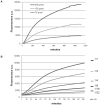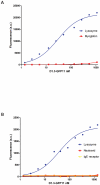Fluorescent labeling of antibody fragments using split GFP
- PMID: 21998685
- PMCID: PMC3187779
- DOI: 10.1371/journal.pone.0025727
Fluorescent labeling of antibody fragments using split GFP
Abstract
Antibody fragments are easily isolated from in vitro selection systems, such as phage and yeast display. Lacking the Fc portion of the antibody, they are usually labeled using small peptide tags recognized by antibodies. In this paper we present an efficient method to fluorescently label single chain Fvs (scFvs) using the split green fluorescent protein (GFP) system. A 13 amino acid tag, derived from the last beta strand of GFP (termed GFP11), is fused to the C terminus of the scFv. This tag has been engineered to be non-perturbing, and we were able to show that it exerted no effect on scFv expression or functionality when compared to a scFv without the GFP11 tag. Effective functional fluorescent labeling is demonstrated in a number of different assays, including fluorescence linked immunosorbant assays, flow cytometry and yeast display. Furthermore, we were able to show that this split GFP system can be used to determine the concentration of scFv in crude samples, as well an estimate of antibody affinity, without the need for antibody purification. We anticipate this system will be of widespread interest in antibody engineering and in vitro display systems.
Conflict of interest statement
Figures







Similar articles
-
Generation and functional characterization of the anti-transferrin receptor single-chain antibody-GAL4 (TfRscFv-GAL4) fusion protein.BMC Biotechnol. 2012 Nov 28;12:91. doi: 10.1186/1472-6750-12-91. BMC Biotechnol. 2012. PMID: 23192001 Free PMC article.
-
Production in yeast of pseudotype virus-like particles harboring functionally active antibody fragments neutralizing the cytolytic activity of vaginolysin.Microb Cell Fact. 2011 Dec 15;10:109. doi: 10.1186/1475-2859-10-109. Microb Cell Fact. 2011. PMID: 22171920 Free PMC article.
-
One-step expression and purification of single-chain variable antibody fragment using an improved hexahistidine tag phagemid vector.Protein Expr Purif. 2009 Dec;68(2):190-5. doi: 10.1016/j.pep.2009.08.004. Epub 2009 Aug 13. Protein Expr Purif. 2009. PMID: 19683057
-
Production and applications of fluorobody from redox-engineered Escherichia coli.Appl Microbiol Biotechnol. 2023 Mar;107(5-6):1959-1970. doi: 10.1007/s00253-023-12395-6. Epub 2023 Feb 2. Appl Microbiol Biotechnol. 2023. PMID: 36729226 Free PMC article.
-
Optimized immobilization of single chain variable fragment antibody onto non-toxic fluorescent nanoparticles for efficient preparation of a bioprobe.Colloids Surf B Biointerfaces. 2023 Apr;224:113192. doi: 10.1016/j.colsurfb.2023.113192. Epub 2023 Feb 2. Colloids Surf B Biointerfaces. 2023. PMID: 36791518 Review.
Cited by
-
An improved Protein G with higher affinity for human/rabbit IgG Fc domains exploiting a computationally designed polar network.Protein Eng Des Sel. 2014 Apr;27(4):127-34. doi: 10.1093/protein/gzu005. Epub 2014 Mar 14. Protein Eng Des Sel. 2014. PMID: 24632761 Free PMC article.
-
Specific cell surface labeling of GPCRs using split GFP.Sci Rep. 2016 Feb 9;6:20568. doi: 10.1038/srep20568. Sci Rep. 2016. PMID: 26857153 Free PMC article.
-
Design of a chromogenic substrate for elastase based on split GFP system-Proof of concept for colour switch sensors.Biotechnol Rep (Amst). 2019 Mar 18;22:e00324. doi: 10.1016/j.btre.2019.e00324. eCollection 2019 Jun. Biotechnol Rep (Amst). 2019. PMID: 31049301 Free PMC article.
-
Construction, characterization and crystal structure of a fluorescent single-chain Fv chimera.Protein Eng Des Sel. 2021 Feb 15;34:gzaa029. doi: 10.1093/protein/gzaa029. Protein Eng Des Sel. 2021. PMID: 33586761 Free PMC article.
-
Direct selection of functional fluorescent-protein antibody fusions by yeast display.PLoS One. 2023 Feb 24;18(2):e0280930. doi: 10.1371/journal.pone.0280930. eCollection 2023. PLoS One. 2023. PMID: 36827414 Free PMC article.
References
-
- Bradbury AR, Marks JD. Antibodies from phage antibody libraries. J Immunol Methods. 2004;290:29–49. - PubMed
-
- Marks JD, Hoogenboom HR, Bonnert TP, McCafferty J, Griffiths AD, et al. By-passing immunization. Human antibodies from V-gene libraries displayed on phage. J Mol Biol. 1991;222:581–597. - PubMed
-
- Boder ET, Wittrup KD. Yeast surface display for screening combinatorial polypeptide libraries. Nat Biotechnol. 1997;15:553–557. - PubMed
Publication types
MeSH terms
Substances
Grants and funding
LinkOut - more resources
Full Text Sources
Other Literature Sources

